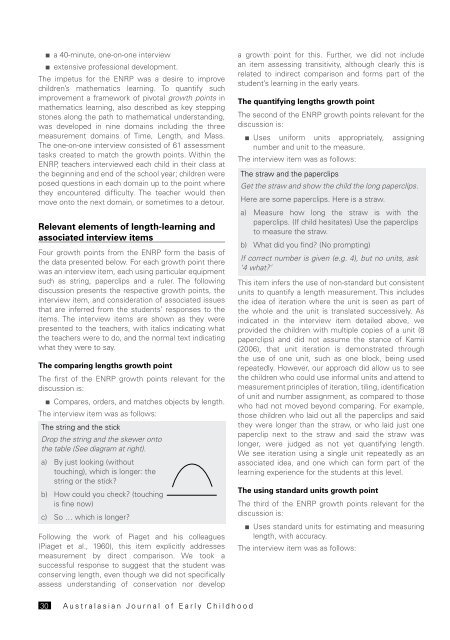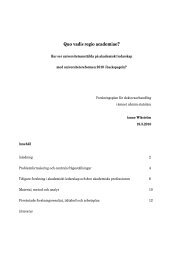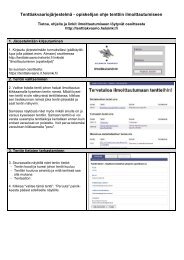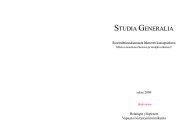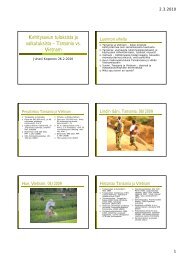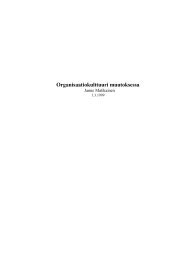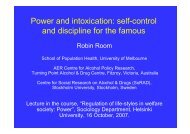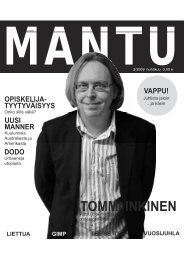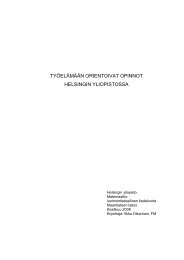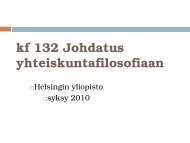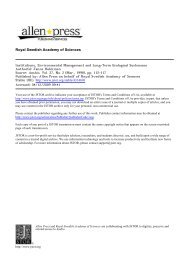■■a 40-minute, one-on-one interview■■extensive pr<strong>of</strong>essional development.The impetus for the ENRP was a desire to improvechildren’s mathematics learning. To quantify suchimprovement a framework <strong>of</strong> pivotal growth points inmathematics learning, also described as key steppingstones along the path to mathematical understanding,was developed in nine domains including the threemeasurement domains <strong>of</strong> Time, Length, and Mass.The one-on-one interview consisted <strong>of</strong> 61 assessmenttasks created to match the growth points. Within theENRP, teachers interviewed each child in their class atthe beginning and end <strong>of</strong> the school year; children wereposed questions in each domain up to the point wherethey encountered difficulty. The teacher would thenmove onto the next domain, or sometimes to a detour.Relevant elements <strong>of</strong> length-learning andassociated interview itemsFour growth points from the ENRP form the basis <strong>of</strong>the data presented below. For each growth point therewas an interview item, each using particular equipmentsuch as string, paperclips and a ruler. The followingdiscussion presents the respective growth points, theinterview item, and consideration <strong>of</strong> associated issuesthat are inferred from the students’ responses to theitems. The interview items are shown as they werepresented to the teachers, with italics indicating whatthe teachers were to do, and the normal text indicatingwhat they were to say.The comparing lengths growth pointThe first <strong>of</strong> the ENRP growth points relevant for thediscussion is:■■Compares, orders, and matches objects by length.The interview item was as follows:The string and the stickDrop the string and the skewer ontothe table (See diagram at right).a) By just looking (withouttouching), which is longer: thestring or the stick?b) How could you check? (touchingis fine now)The string and the stickc) So … which is longer?Following the work <strong>of</strong> Piaget and his colleagues(Piaget et al., 1960), this item explicitly addressesmeasurement by direct comparison. We took asuccessful response to suggest that the student wasconserving length, even though we did not specificallyassess understanding <strong>of</strong> conservation nor developa growth point for this. Further, we did not includean item assessing transitivity, although clearly this isrelated to indirect comparison and forms part <strong>of</strong> thestudent’s learning in the early years.The quantifying lengths growth pointThe second <strong>of</strong> the ENRP growth points relevant for thediscussion is:■■Uses uniform units appropriately, assigningnumber and unit to the measure.The interview item was as follows:The straw and the paperclipsGet the straw and show the child the long paperclips.Here are some paperclips. Here is a straw.a) Measure how long the straw is with thepaperclips. (If child hesitates) Use the paperclipsto measure the straw.b) What did you find? (No prompting)If correct number is given (e.g. 4), but no units, ask‘4 what?’This item infers the use <strong>of</strong> non-standard but consistentunits to quantify a length measurement. This includesthe idea <strong>of</strong> iteration where the unit is seen as part <strong>of</strong>the whole and the unit is translated successively. Asindicated in the interview item detailed above, weprovided the children with multiple copies <strong>of</strong> a unit (8paperclips) and did not assume the stance <strong>of</strong> Kamii(2006), that unit iteration is demonstrated throughthe use <strong>of</strong> one unit, such as one block, being usedrepeatedly. However, our approach did allow us to seethe children who could use informal units and attend tomeasurement principles <strong>of</strong> iteration, tiling, identification<strong>of</strong> unit and number assignment, as compared to thosewho had not moved beyond comparing. For example,those children who laid out all the paperclips and saidthey were longer than the straw, or who laid just onepaperclip next to the straw and said the straw waslonger, were judged as not yet quantifying length.We see iteration using a single unit repeatedly as anassociated idea, and one which can form part <strong>of</strong> thelearning experience for the students at this level.The using standard units growth pointThe third <strong>of</strong> the ENRP growth points relevant for thediscussion is:■■Uses standard units for estimating and measuringlength, with accuracy.The interview item was as follows:30A u s t r a l a s i a n J o u r n a l o f E a r l y C h i l d h o o d
Using the rulerHere is a ruler. (Give the ruler to the child in her/hishand.)Here is a straw (20 cm).a) Please measure the straw with the ruler.b) What did you find?If correct number is given (20) but no units, ask ‘20what?’Following the assessment <strong>of</strong> use <strong>of</strong> non-standard units,we investigated children’s use <strong>of</strong> standard units andrelated measurement tools. The present growth pointand interview item refer to the use <strong>of</strong> the formal unit,the centimetre, and an appropriate measurement tool,the ruler, to quantify lengths.Classroom teachers trained in interviewing andrecording conducted the one-on-one interviews, usingthe script and pre-prepared equipment. The datafrom this project arise from intensive interviews withlarge numbers <strong>of</strong> children, with trained interviewersand experienced coders, with double data entry. Theprocesses for assuring reliability <strong>of</strong> scoring and codingare outlined in Rowley and Horne (2000). As far aspossible in such situations, the pr<strong>of</strong>ile <strong>of</strong> responsespresented here can be taken as a reasonablerepresentation <strong>of</strong> how students in Victorian schoolswould respond to such tasks.Our focus <strong>of</strong> interest in this article is on whether thedata support the contention that the proposed lengthgrowth points describe goals for student learning overthe first years <strong>of</strong> schooling, and on how teachers mighthelp children reach these goals.ResultsTo convey the sense <strong>of</strong> concept development that can begained from the data, we first examine overall trends inthe data, and then examine the three key learning stages<strong>of</strong> comparing lengths, unit iteration, and using standardunits, using data from the most relevant year level.Overall trends in the dataTo examine the way the responses to the length itemsportray the increasing sophistication <strong>of</strong> the students’strategies, Table 1 presents a pr<strong>of</strong>ile <strong>of</strong> students’achievement in the length domain over the first threeyears <strong>of</strong> school. In Victoria children start school at aroundfive years <strong>of</strong> age. The data represent the percentage <strong>of</strong>the project school students at their highest achievedgrowth point by grade level in the March interview in theirfirst year <strong>of</strong> school, and the November interview in each<strong>of</strong> the three years <strong>of</strong> the project, along with the equivalentreference school students at the end <strong>of</strong> their third year <strong>of</strong>school. Only students in project schools who participatedin all four assessments are included in this analysis.As can be seen, the students in the project schoolsdemonstrated improvement over time on these items.In terms <strong>of</strong> progress on each <strong>of</strong> the key growth levels:■■at the end <strong>of</strong> the first year <strong>of</strong> school (Grade Prepin Victoria) only 5 per cent <strong>of</strong> students are notcomparing lengths, suggesting that this keyfoundational concept is learned by most studentsafter one year at school. There is still a need toconsider the implications for the 5 per cent, orroughly one student per class, who have notlearned to do this.■■by the end <strong>of</strong> the third year <strong>of</strong> school (Grade Twoin Victoria), 12 per cent <strong>of</strong> project school students,and 17 per cent <strong>of</strong> the reference school studentsdid not respond successfully to the unit iterationitem, which required the students to count thenumber <strong>of</strong> paperclips needed to quantify thelength <strong>of</strong> the straw. This seems to be an importantissue for these students, since presumably thiswould be a prerequisite to the learning <strong>of</strong> allsubsequent measurement concepts, and is animportant focus for teachers’ attention. That 31 percent <strong>of</strong> students in project schools did not respondsuccessfully to the unit iteration item at the end <strong>of</strong>the second year <strong>of</strong> school (Grade One in Victoria)suggests this would be a suitable year level forspecific teacher attention to ways <strong>of</strong> supportingthis aspect <strong>of</strong> students’ learning.Table 1. Students (per cent) achieving length growth points over timeSchool entry(n = 839)End <strong>of</strong> 1styear <strong>of</strong> school(n = 839)End <strong>of</strong> 2ndyear <strong>of</strong> school(n = 839)End <strong>of</strong> 3rdyear <strong>of</strong> school(n = 839)Reference schools: End<strong>of</strong> 3rd year <strong>of</strong> school(n = 217)Not yet comparing 30 5 0 0 1lengthsComparing lengths 53 35 31 12 17Unit iteration 17 54 42 16 43Using standard units 1 7 22 53 32Beyond usingstandard units0 0 5 19 7Vo l u m e 3 6 N u m b e r 3 S e p t e m b e r 2 011 31
- Page 3 and 4: 1.5 Display, download or print the
- Page 5 and 6: Volume 36 Number 3 September 2011Jo
- Page 7 and 8: Curriculum guidelines for early lit
- Page 9 and 10: ■■Know that print carries meani
- Page 14 and 15: Korean children’s cultural adjust
- Page 16 and 17: The Early Years Learning Framework
- Page 18: Kyung Min said listening in class w
- Page 21 and 22: immediately impact on children’s
- Page 23 and 24: Child participation in the early ye
- Page 25 and 26: their kindergarten day. A study by
- Page 27 and 28: the overall organisation, routines,
- Page 29 and 30: Council of Australian Governments (
- Page 31: Learning to measure length in the f
- Page 36 and 37: ■■72 per cent of the project sc
- Page 38 and 39: In other words, the difficulties th
- Page 40 and 41: An analysis of New Zealand’s chan
- Page 42 and 43: Before five also gave equivalent st
- Page 44 and 45: some evidence that curriculum effec
- Page 46 and 47: achievement; aiding transition to s
- Page 49 and 50: ‘It’s a mystery!’A case study
- Page 51: analysis of discourse the children
- Page 56 and 57: ange of objects on the floor (such
- Page 58 and 59: Observation and recording informati
- Page 60 and 61: ‘I’m making it different to the
- Page 62 and 63: Purpose and theoretical frameworkIn
- Page 64 and 65: The fingers were reaching out acros
- Page 66 and 67: Figure 7. ‘I take this lovely lad
- Page 68 and 69: Here, Rachel used substitution to r
- Page 70: Evaluating the feasibility, effecti
- Page 73 and 74: Table 2. Descriptive characteristic
- Page 75 and 76: The children in this study were fro
- Page 77 and 78: Vol. 36 No. 3 September 2011Austral
- Page 79 and 80: implement the curriculum effectivel
- Page 81 and 82: Table 2. Mean differences between H
- Page 83 and 84: can be regarded as one of the infor
- Page 85 and 86:
Ganser, T. (2000). An ambitious vis
- Page 87 and 88:
(Buckhalt et al., 2009). Reduced qu
- Page 89 and 90:
invited families having difficulty
- Page 91 and 92:
Table 3. Mean hours of mother and f
- Page 93 and 94:
A reduction in night wakings might
- Page 95 and 96:
A preliminary exploration of childr
- Page 97 and 98:
adult support necessary for its eff
- Page 99 and 100:
Children’s cortisol and alpha-amy
- Page 102 and 103:
Connor, C., Son, S.-H., Hindman, A.
- Page 104 and 105:
Equity of access:Requirements of In
- Page 106 and 107:
excursions, which have been reporte
- Page 108 and 109:
We need a bus but we also need a st
- Page 110 and 111:
Appropriate child careIndigenous fa
- Page 112 and 113:
Australian Institute of Health and
- Page 114 and 115:
The Mosaic Approach relies on child
- Page 116 and 117:
participants (Altrichter, Posch, &
- Page 118 and 119:
distance. This involved trying to b
- Page 120 and 121:
Dockett, S., & Perry, B. (2003). Ch
- Page 122 and 123:
experiences (Bandura, 1997). Belief
- Page 124 and 125:
the curriculum while on their profe
- Page 126 and 127:
Exploring and evaluating levels of
- Page 128 and 129:
Level 2: Attending to feelingsThis
- Page 130 and 131:
This process to ensure coder stabil
- Page 132 and 133:
DiscussionStructured reflective pro
- Page 134 and 135:
Rock, T. C., & Levin, B. B. (2002).
- Page 136 and 137:
issues encountered in their caring
- Page 138 and 139:
pertaining to the impact and suppor
- Page 140 and 141:
Parents felt the policies involving
- Page 142 and 143:
and access suitable carers because
- Page 144 and 145:
Ievers, C. E., & Drotar, D. (1996).
- Page 146:
www.earlychildhoodaustralia.org.auE


